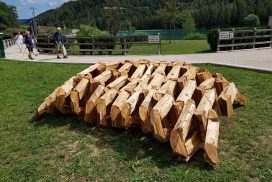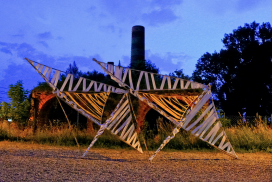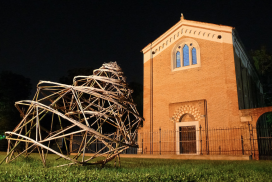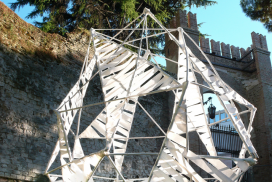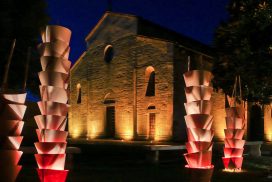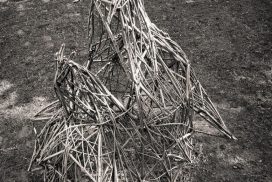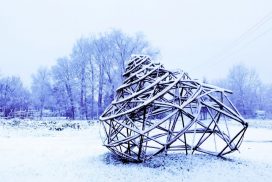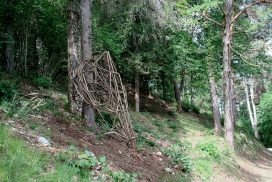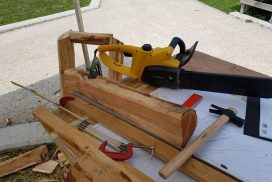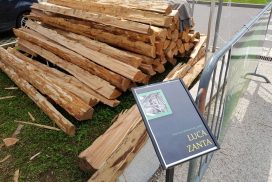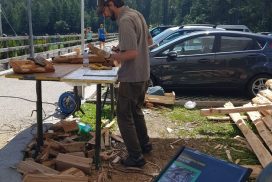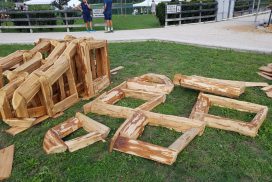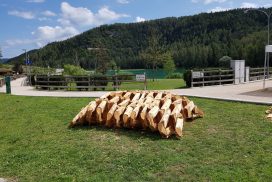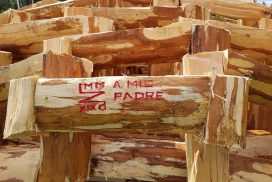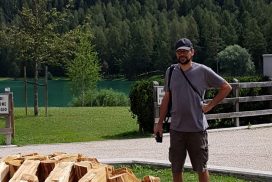Luca Zanta – Colomela Art
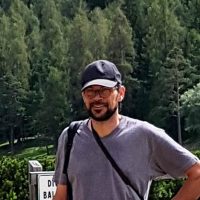
Wir kennen den Künstler:
1973 in Padua geboren, lebt er in Montegrotto Terme. 1992 erwarb er das Abitur in angewandter Kunst am Institut für Kunst P. Selvatico in Padua.
In den 90er Jahren beschäftigte er sich hauptsächlich mit angewandter Kunst, experimentierte mit verschiedenen Techniken, hauptsächlich bildnerischen, in verschiedenen Bereichen: Entwurf und Bau von szenografischen Installationen, Wandarbeiten und grafischen Projekten, Erfahrungen in der Musikwelt; Endlich kam die Fotografie.
2006 schloss er sein Architekturstudium an der IUAV in Venedig nach einem an historisch-künstlerischen Studiengängen orientierten Studienplan mit einer Diplomarbeit zum Thema Design ab.
In den letzten Jahren widmete er sich hauptsächlich der Manipulation digitaler Fotografie, 3D-Modellierung und deren möglichen Wechselwirkungen, auch mit Multimedia-Produktionen und Videoprojektionen.
Derzeit arbeitet er mit verschiedenen professionellen Studios zusammen und betreibt gleichzeitig künstlerische Forschung. Aktuelle Forschung zielt darauf ab, die möglichen Hybridisierungen zwischen digitalen und analogen Techniken zu untersuchen.
Nach einem Abschluss in Angewandter Kunst und einem Abschluss in Architektur begann er seine Aktivitäten auf der rein visuellen Seite des künstlerischen Schaffens mit traditionellen Techniken wie Zeichnen, Malen und Airbrush und wechselte allmählich zu digitalen Techniken. Derzeit führt er einige Projekte für szenische / architektonische Installationen im öffentlichen Raum durch.
Aus gestalterischer Sicht arbeitet er normalerweise für bestimmte Werkserien. Jede Serie kann unterschiedliche technische Ausführungsmethoden haben, eine der Konstanten der Forschung ist die Tendenz zur Hybridisierung.
Er hat viele Einzelausstellungen in Padua und Umgebung organisiert und an verschiedenen Gruppenausstellungen, Wettbewerben und Messen in den Provinzen Padua, Rovigo, Venedig, Savona, Benevento, Bologna, Ferrara, Mailand, Rom, Varese, Mestre, Treviso teilgenommen , Brescia, Pescara, Levico Terme, Stenico, Berlin und Oregon.
Umsetzung für das Symposium von Predaia 2023:
Das von Luca vorgeschlagene Werk heißt „Fucina“.
Dem Mythos zufolge hatte Hephaistos seine Schmiede auf dem Ätna und anderen Vulkanen.
Das Projekt greift das ikonische Element des Vulkans auf und verwandelt ihn in eine kleine Gartenarchitektur, die in ihrer Kegelstumpfform auch an eine Art antiken Schmelzofen für Metalle erinnert.
Ein Loch ermöglicht den kleineren Personen den Zugang.
Nach Möglichkeit wird die Anlage mit einem kleinen Feuer im Inneren eingeweiht, das die Schmiede zum Leben erweckt.

We know the Artist:
Born in Padua in 1973, he lives in Montegrotto Terme. In 1992 he obtained a high school diploma in applied art at the P. Selvatico Institute of Art in Padua. In the 90s he mainly dealt with applied art, experimented with various techniques, mainly pictorial, in different fields: design and construction of scenographic installations, mural works and graphic projects, experiences in the musical world; finally came photography.
In 2006 she graduated in Architecture at the IUAV in Venice, following a study plan oriented to historical-artistic courses, and with a degree thesis on design.
In the last few years you have mainly devoted yourself to the manipulation of digital photography, 3D modeling, and their possible interactions, including with multimedia productions and video projections.
Currently he collaborates with various professional studios, and at the same time carries on artistic research. Current research aims to explore the possible hybridizations between digital and analog techniques.
Graduated in Applied Art and graduated in Architecture, on the more purely visual side of artistic doing he began his activities with traditional techniques, such as drawing, painting, airbrushing, gradually moving to digital techniques. He is currently carrying out some projects for scenic / architectural installations in public areas.
He usually works for distinct series of works, from a design perspective. Each series can have different technical execution methods, one of the constants of the research is the tendency to hybridization.
He has organized many personal exhibitions in Padua and its surroundings, and has participated in various group exhibitions, competitions and fairs in the provinces of Padua, Rovigo, Venice, Savona, Benevento, Bologna, Ferrara, Milan, Rome, Varese, Mestre, Treviso, Brescia, Pescara, Levico Terme, Stenico, Berlin and Oregon.
Luca has also already participated in the first 2019 edition of the „Predaia Arte e Natura“ symposium, creating the work of Colomela Art entitled „Suspended Dreams“.
Proposal for the Predaia Symposium 2023:
The work proposed by Luca is entitled „Fucina“.
According to the myth, Hephaestus had his forge on Mount Etna and other volcanoes.
The project takes up the iconic element of the volcano, transforming it into a small garden architecture, which in its truncated cone shape also refers to a sort of ancient furnace for melting metals.
A hole will allow those who are smaller to access inside.
If possible, the installation will be inaugurated with a small fire inside, which will bring the forge to life.

Conosciamo l’Artista:
Nasce a Padova nel 1973, vive a Montegrotto Terme. Nel 1992 consegue il diploma di maturità d’Arte applicata all’Istituto Statale d’Arte P. Selvatico di Padova. Negli anni ’90 si occupa principalmente di arte applicata, sperimenta varie tecniche, prevalentemente pittoriche, in ambiti diversi: progettazione e realizzazione di allestimenti scenografici, opere murali e progetti grafici, esperienze nel mondo musicale; infine è venuta la fotografia.
Nel 2006 si laurea in Architettura allo IUAV di Venezia, seguendo un piano di studi orientato ai corsi storico-artistici, e con una tesi di laurea di progettazione.
Negli ultimi anni si è dedicato in modo preponderante alla manipolazione della fotografia digitale, alla modellazione 3D, e alle loro possibili interazioni, anche con produzioni multimediali e videoproiezioni.
Attualmente collabora con vari studi professionali, e parallelamente porta avanti la ricerca artistica. Le ricerche attuali puntano a esplorare le possibili ibridazioni tra tecniche digitali e analogiche.
Diplomato in Arte Applicata e laureato in Architettura, sul versante più prettamente visivo del fare artistico ha iniziato le sue attività con le tecniche tradizionali, quali il disegno, la pittura, l’aerografia, passando gradualmente alle tecniche digitali. Attualmente sta portando avanti alcuni progetti per installazioni scenografiche/architettoniche in aree pubbliche.
Lavora solitamente per serie distinte di opere, in un’ottica progettuale. Ogni serie può avere diverse modalità tecniche di esecuzione, una delle costanti della ricerca è la tendenza all’ibridazione.
Ha organizzato molte mostre personali a Padova e dintorni, ed ha partecipato a varie mostre collettive, concorsi e fiere nelle province di Padova, Rovigo, Venezia, Savona, Benevento, Bologna, Ferrara, Milano, Roma, Varese, Mestre, Treviso, Brescia, Pescara, a Levico Terme, a Stenico, a Berlino e in Oregon.
Luca ha inoltre già partecipato alla prima edizione 2019 del Simposio „Predaia Arte e Natura“ realizzando l’opera di Colomela Art intitolata „Sogni sospesi“.
Proposta per il Simposio di Predaia 2023:
L’opera proposta da Luca si intitola „Fucina“.
Secondo il mito, Efesto aveva la sua fucina nel monte Etna e in altri vulcani.
Il progetto riprende l’elemento iconico del vulcano, trasformandolo in una piccola architettura da giardino, che nella sua forma tronco-conica rimanda anche a una sorta di antico forno per la fusione dei metalli.
La costruzione inizierà tracciando nel terreno una serie di cerchi concentrici, che serviranno da riferimento. Si innalzerà un treppiede, sul quale verranno appoggiate le colomele che formeranno il cratere/ciminiera. Potrà essere d’aiuto una “dima” in legno precedentemente costruita e avvitata sopra il treppiede. Ognuna sarà precedentemente forata nello spigolo rivolto all’interno; un robusto filo metallico, che passerà per i fori e, formando un anello, terrà in posizione i fusti. Eventualmente la giunzione sarà rinforzata con altri elementi
metallici applicati sulle teste. La base delle colomele sarà leggermente interrata, per non farle scivolare durante l’assemblaggio; la struttura si manterrà in piedi grazie al suo stesso peso. Una volta tolto il treppiede, verrà aggiunto un altro giro di colomele, con le teste appuntite e inserite negli spazi tra quelle iniziali, abbassante di 50 cm rispetto alle prime, e collegandole con un altro filo passante. Si procederà ripetendo l’operazione fino a terra, formando infine un cono. La sommità verrà resa più scura, spennellandola con catrame diluito.
Le scandole, o parti di esse, verranno usate per essere inserite negli interstizi.
Un pertugio permetterà a chi è più piccolo di accedere all’interno.
Se sarà possibile, si inaugurerà l’installazione con un piccolo fuoco all’interno, che darà vita alla fucina.
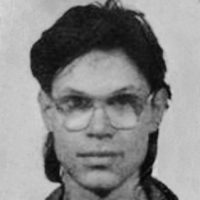
Wir kennen den Künstler:
1973 in Padua geboren, lebt er in Montegrotto Terme. 1992 erwarb er das Abitur in angewandter Kunst am Institut für Kunst P. Selvatico in Padua. In den 90er Jahren beschäftigte er sich hauptsächlich mit angewandter Kunst, experimentierte mit verschiedenen Techniken, hauptsächlich bildnerischen, in verschiedenen Bereichen: Entwurf und Bau von szenografischen Installationen, Wandarbeiten und grafischen Projekten, Erfahrungen in der Musikwelt; Endlich kam die Fotografie.
2006 schloss er sein Architekturstudium an der IUAV in Venedig nach einem an historisch-künstlerischen Studiengängen orientierten Studienplan mit einer Diplomarbeit zum Thema Design ab.
In den letzten Jahren widmete er sich hauptsächlich der Manipulation digitaler Fotografie, 3D-Modellierung und deren möglichen Wechselwirkungen, auch mit Multimedia-Produktionen und Videoprojektionen.
Derzeit arbeitet er mit verschiedenen professionellen Studios zusammen und betreibt gleichzeitig künstlerische Forschung. Aktuelle Forschung zielt darauf ab, die möglichen Hybridisierungen zwischen digitalen und analogen Techniken zu untersuchen.
Nach einem Abschluss in Angewandter Kunst und einem Abschluss in Architektur begann er seine Aktivitäten auf der rein visuellen Seite des künstlerischen Schaffens mit traditionellen Techniken wie Zeichnen, Malen und Airbrush und wechselte allmählich zu digitalen Techniken. Derzeit führt er einige Projekte für szenische / architektonische Installationen im öffentlichen Raum durch.
Aus gestalterischer Sicht arbeitet er normalerweise für bestimmte Werkserien. Jede Serie kann unterschiedliche technische Ausführungsmethoden haben, eine der Konstanten der Forschung ist die Tendenz zur Hybridisierung.
Er hat viele Einzelausstellungen in Padua und Umgebung organisiert und an verschiedenen Gruppenausstellungen, Wettbewerben und Messen in den Provinzen Padua, Rovigo, Venedig, Savona, Benevento, Bologna, Ferrara, Mailand, Rom, Varese, Mestre, Treviso teilgenommen , Brescia, Pescara, Levico Terme, Stenico, Berlin und Oregon.
Umsetzung für das Symposium von Predaia 2019:
Das Thema des Traums, verstanden als die traumhafte Tätigkeit des Schlafes, wird auf anspielungsreiche Weise behandelt und repräsentiert seine momentane Abwesenheit.
In greifbarer Realität die physische Spur des Ortes dokumentieren, an dem sie sich manifestiert hat.
Die Installation stellt ein soeben zurückgelassenes Kissen mit einem Becken im Mittelteil dar, also den Abdruck, den der gerade erwachte Träumer hinterlassen hat.
Die Konstruktionstechnik definiert die Form eher vage, wie die Bilder und Situationen, die in Träumen entstehen. Der vergrößerte Maßstab des Kissens ordnet es deutlich in den Bereich der Träume ein.
Titel der Arbeit „Sogni sospesi“.

We know the Artist:
Born in Padua in 1973, he lives in Montegrotto Terme. In 1992 he obtained a high school diploma in applied art at the P. Selvatico Institute of Art in Padua. In the 90s he mainly dealt with applied art, experimented with various techniques, mainly pictorial, in different fields: design and construction of scenographic installations, mural works and graphic projects, experiences in the musical world; finally came photography.
In 2006 she graduated in Architecture at the IUAV in Venice, following a study plan oriented to historical-artistic courses, and with a degree thesis on design.
In the last few years you have mainly devoted yourself to the manipulation of digital photography, 3D modeling, and their possible interactions, including with multimedia productions and video projections.
Currently he collaborates with various professional studios, and at the same time carries on artistic research. Current research aims to explore the possible hybridizations between digital and analog techniques.
Graduated in Applied Art and graduated in Architecture, on the more purely visual side of artistic doing he began his activities with traditional techniques, such as drawing, painting, airbrushing, gradually moving to digital techniques. He is currently carrying out some projects for scenic / architectural installations in public areas.
He usually works for distinct series of works, from a design perspective. Each series can have different technical execution methods, one of the constants of the research is the tendency to hybridization.
He has organized many personal exhibitions in Padua and its surroundings, and has participated in various group exhibitions, competitions and fairs in the provinces of Padua, Rovigo, Venice, Savona, Benevento, Bologna, Ferrara, Milan, Rome, Varese, Mestre, Treviso, Brescia, Pescara, Levico Terme, Stenico, Berlin and Oregon.
Realization for the Symposium of Predaia 2019:
The theme of the dream, understood as the oneiric activity of sleep, is dealt with in an allusive way, representing its momentary absence.
Documenting, in tangible reality, the physical trace of the place where it manifested itself.
The installation represents a cushion that has just been left, with a basin in the central part, that is, the imprint that the dreamer, just awakened, has left.
The construction technique defines the form in a somewhat vague way, like the images and situations that arise in dreams. The scale of the pillow, enlarged, places it clearly in the field of reveries.
Title of the work „Suspended dreams“.

Conosciamo l’Artista:
Nasce a Padova nel 1973, vive a Montegrotto Terme. Nel 1992 consegue il diploma di maturità d’Arte applicata all’Istituto Statale d’Arte P. Selvatico di Padova. Negli anni ’90 si occupa principalmente di arte applicata, sperimenta varie tecniche, prevalentemente pittoriche, in ambiti diversi: progettazione e realizzazione di allestimenti scenografici, opere murali e progetti grafici, esperienze nel mondo musicale; infine è venuta la fotografia.
Nel 2006 si laurea in Architettura allo IUAV di Venezia, seguendo un piano di studi orientato ai corsi storico-artistici, e con una tesi di laurea di progettazione.
Negli ultimi anni si è dedicato in modo preponderante alla manipolazione della fotografia digitale, alla modellazione 3D, e alle loro possibili interazioni, anche con produzioni multimediali e videoproiezioni.
Attualmente collabora con vari studi professionali, e parallelamente porta avanti la ricerca artistica. Le ricerche attuali puntano a esplorare le possibili ibridazioni tra tecniche digitali e analogiche.
Diplomato in Arte Applicata e laureato in Architettura, sul versante più prettamente visivo del fare artistico ha iniziato le sue attività con le tecniche tradizionali, quali il disegno, la pittura, l’aerografia, passando gradualmente alle tecniche digitali. Attualmente sta portando avanti alcuni progetti per installazioni scenografiche/architettoniche in aree pubbliche.
Lavora solitamente per serie distinte di opere, in un’ottica progettuale. Ogni serie può avere diverse modalità tecniche di esecuzione, una delle costanti della ricerca è la tendenza all’ibridazione.
Ha organizzato molte mostre personali a Padova e dintorni, ed ha partecipato a varie mostre collettive, concorsi e fiere nelle province di Padova, Rovigo, Venezia, Savona, Benevento, Bologna, Ferrara, Milano, Roma, Varese, Mestre, Treviso, Brescia, Pescara, a Levico Terme, a Stenico, a Berlino e in Oregon.
Realizzazione per il Simposio di Predaia 2019 – tema „i sogni“:
Il tema del sogno, inteso come attività onirica propria del sonno, viene affrontato in modo allusivo, rappresentandone la momentanea assenza.
Documentandone, nella realtà tangibile, la traccia fisica del luogo in cui si è manifestato.
L’installazione rappresenta un cuscino appena lasciato, con una conca nella parte centrale, cioè l’impronta che il sognatore, appena destato, ha lasciato.
La tecnica costruttiva definisce la forma in modo un pò vago, come le immagini e le situazioni che si presentano nei sogni. La scala del cuscino, ingigantita, lo colloca con evidenza nell’ambito delle fantasticherie.
Titolo dell’opera „Sogni sospesi“.
